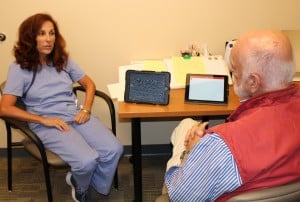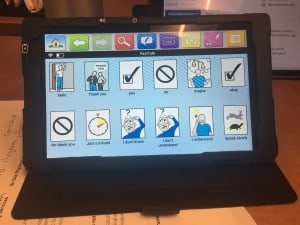Stroke can thrust patients into a world of silence if it impacts the speech centers of their brains. But they are finding their way back – and new hope – thanks to technology.
Johnna Johnson is a speech-language pathologist with Regional One Health. She works with stroke patients at the East Campus Center for Rehabilitative Medicine.

Speech-language pathologist Johnna Johnson is certified to help patients use adaptive technology to help with speech and communication.
“Stroke can result in problems speaking and understanding to the point where patients are primarily silent, or non-verbal,” she said. “But they don’t have to be silent. They can still communicate their wants and needs; they can still communicate with their family and understand the world around them.”
Johnson is a Certified Lingraphica Technology Specialist. She can assess patients and help them use a device to communicate. Devices range from simple to complex based on a patient’s needs.
Very few speech-language pathologists have the certification. This gives Johnson a unique way to help patients in the Mid-South.
The devices Johnson uses are similar in size and design to a tablet or e-reader. They feature a touch screen with a series of icons. The icons feature both words and corresponding images.
“A lot of my patients have lost the ability to read and understand spoke language,” Johnson explained. “This gives them the opportunity to have a system of pictures they can use to communicate and understand better.”

Patients can communicate by tapping icons on devices that are similar in size and design to tablets or e-readers.
Johnson said at the simplest, the icons cover common words and phrases:
- Hello
- Thank you/no thank you
- Yes, no or maybe
- Just a minute
- I don’t know
- I understand/I don’t understand
- Speak slowly
Another screen shows a variety of categories:
- Me
- Medical Information
- My food
- People
- Going out
- Therapy
Clicking on one of these icons gives even more in-depth, personalized choices.
For example, Johnson said, under food patients can list their allergies and favorites. They can create their own meal plans. Categories even break down by the various food groups.

Communication devices can be personalized with the patient’s favorite foods, therapy exercises, family photos, etc.
By clicking the “I want” icon, patients can communicate which food they are hungry for.
Family members can even upload photos of specific dishes or meals. “I can create them to be as personalized as we want,” she said.
Patients can include photos of family and pets. Johnson can give them individualized therapy and exercise plans.
Johnson said the devices help patients while they are at home or out and about. “It’s a really good device,” she said. “It’s compact. They can put it in their purse or pocket and take it with them.”
Armed with the device, she said, her patients can participate more fully in life. “Instead of being silent in a room full of people, they can do a conversation starter and communicate their wants and needs,” Johnson said. “It gives my stroke patients some hope.”